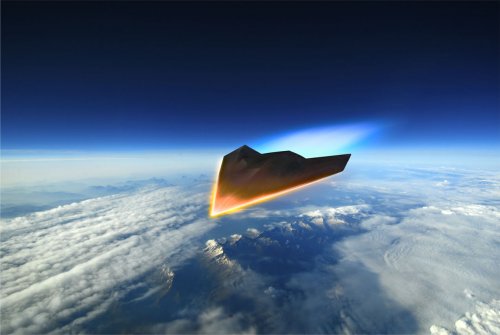China Conducts Fourth Test of Wu-14 Strike Vehicle
Posted By
Bill Gertz On June 11, 2015 @ 5:00 am In
National Security |
No Comments
China this week carried out the fourth test of an ultra high-speed nuclear delivery vehicle that conducted what intelligence officials say were extreme maneuvers.
The test of the Wu-14 hypersonic strike vehicle was carried out Sunday, launched atop a ballistic missile fired from a test facility in western China.
It was the fourth successful test of the Wu-14 in the past 18 months and the frequency of tests is being viewed by U.S. intelligence analysts as an indicator of the high priority placed on developing the weapon by the Chinese.
Earlier tests took place last year on
Jan. 9,
Aug. 7, and
Dec. 2. The
Washington Free Beacon first reported the tests.
The new strike vehicle is considered a high-technology strategic weapon capable of delivering nuclear or conventional warheads while traveling on the edge of space. One of its key features is the ability to maneuver to avoid U.S. missile defenses.
The Wu-14 was assessed as traveling up to 10 times the speed of sound, or around 7,680 miles per hour.
Unlike earlier tests, the latest test demonstrated what one official called “extreme maneuvers” that appeared to analysts designed for penetrating through missile defense systems.
Current U.S. missile defenses are limited to knocking out missiles and their warheads with predictable ballistic trajectories that can be tracked with relative ease by satellite sensors and ground and sea radar.
However, the Wu-14 threatens to neutralize U.S. strategic missile defenses with the unique capability of flying at ultra high speeds and maneuvering to avoid detection and tracking by radar and missile defense interceptors.
The Pentagon’s Missile Defense Agency has repeatedly declined to comment on whether current U.S. missile defenses can defeat maneuvering targets.
A congressional China commission stated in a report published in November that China is working on hypersonic arms as “a core component of its next-generation precision strike capability.”
“Hypersonic glide vehicles could render existing U.S. missile defense systems less effective and potentially obsolete,” the report said.
In addition to the glide vehicle, China also is developing a second hypersonic weapon the uses a high-technology scramjet engine.
The Pentagon and China’s defense ministry confirmed the earlier tests. Asked about the latest test, however, Pentagon spokesman Lt. Col. Jeff Pool declined to comment on the test, citing a policy of not discussing intelligence matters.
However, specialists on China’s military buildup say the latest test is another significant milestone for Chinese long-range strike capabilities.
“With four tests in about a year and a half, it is possible that China could conclude development of an early version for deployment in one to two years,” said Rick Fisher, a China expert with the International Assessment and Strategy Center.
Former Pentagon official Mark Stokes, also a China weapons specialist, said the People’s Liberation Army and China’s space and missile industry have been conducting engineering design work on a boosted hypersonic glide vehicle for some time. “Certification of the design requires prototype testing of the post boost vehicle, which is probably what’s going on,” said Stokes, now with the Project 2049 Institute, a think tank.
“Fielding of a hypersonic glide vehicle would advance the PLA’s ability to hold U.S. targets at risk, as well as those of allies and partners,” Stokes added.
Lora Saalman, a professor at the Daniel K. Inouye Asia-Pacific Center for Security Studies, the latest Wu-14 test indicates the weapon is a high priority.
“This test is keeping in line with China’s fast-tracking of this program and efforts to expand not just the range but also the capabilities and maneuverability of the system,” she said.
Fisher said he suspects an early version of the Wu-14 will be launched atop a DF-21 medium-range ballistic missile, although in the future it would be carried by the 2,485-mile range DF-26.
“Perhaps the most important U.S. antidote for China’s hypersonic maneuvering warhead is U.S. energy weapons programs,” Fisher said.
“There is an urgent need to increase funding to accelerate the early deployment of rail gun weapons.”
Rail guns fire shotgun-style pellets at hypersonic speeds that create pellet clouds that can be used to damage or destroy Chinese hypersonic warheads.
“It is urgent that the U.S. speed the deployment of rail guns to defend aircraft carriers, large combat ships, and major U.S. military facilities in Asia,” he said.
“The U.S. also needs to accelerate the development of its own hypersonic weapons, ground, air, and sea-launched, to deter China’s use of these weapons.”
The current House version of the fiscal 2016 defense authorization bill calls for the Pentagon to conduct advanced technology war games, including those involving hypersonic strike systems.
The bill includes $291 million for an extended-range variant of Army’s Terminal High Altitude Area Defense, or THAAD, missile defense system to deal with hypersonic threats.
“The committee is aware of the rapidly evolving threat from potential adversaries’ development of hypersonic weapons,” the report on the bill says, noting China’s several recent tests.
“The [Armed Services] committee believes this rapidly emerging capability could be a threat to national security and our operational forces,” the report said.
The Army has conducted two tests of its Advanced Hypersonic Weapon and in the latest test the missile launcher blew up shortly after liftoff.
The committee called on the military to develop hypersonic targets to improve U.S. defenses.
A Chinese Embassy spokesman did not return an email seeking comment.
In the past, China’s government has called the hypersonic tests normal military experiments.

